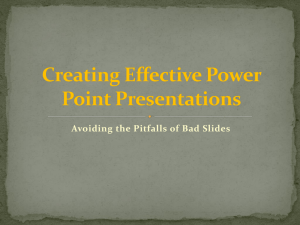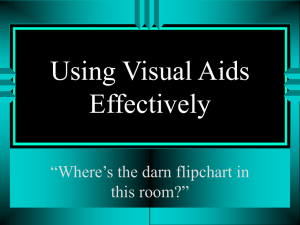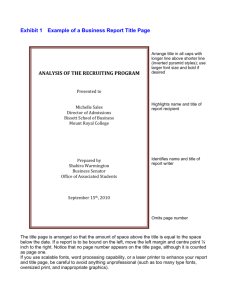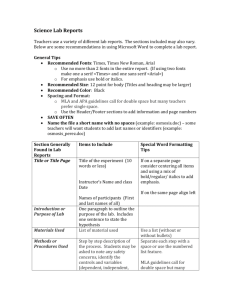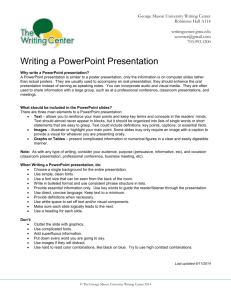Death by PowerPoint The ultimate dull life experience
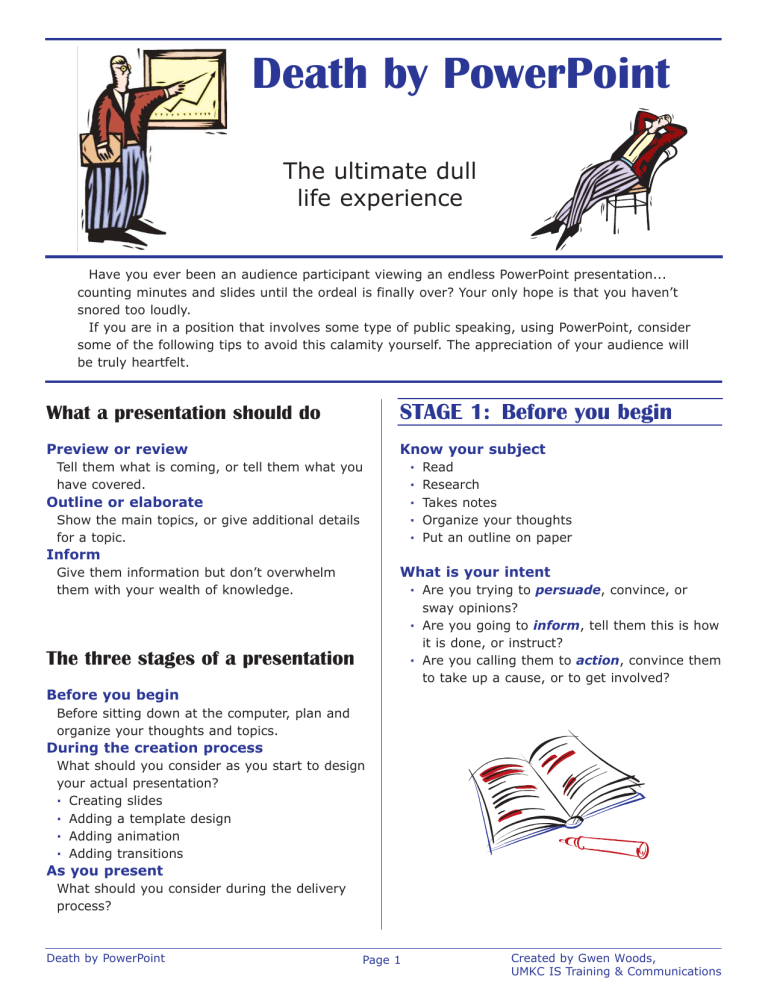
Death by PowerPoint
The ultimate dull life experience
Have you ever been an audience participant viewing an endless PowerPoint presentation...
counting minutes and slides until the ordeal is finally over? Your only hope is that you haven’t snored too loudly.
If you are in a position that involves some type of public speaking, using PowerPoint, consider some of the following tips to avoid this calamity yourself. The appreciation of your audience will be truly heartfelt.
What a presentation should do
Preview or review
Tell them what is coming, or tell them what you have covered.
Outline or elaborate
Show the main topics, or give additional details for a topic.
Inform
Give them information but don’t overwhelm them with your wealth of knowledge.
STAGE 1: Before you begin
Know your subject
· Read
· Research
· Takes notes
· Organize your thoughts
· Put an outline on paper
What is your intent
· Are you trying to persuade , convince, or sway opinions?
· Are you going to inform , tell them this is how it is done, or instruct?
· Are you calling them to action , convince them to take up a cause, or to get involved?
The three stages of a presentation
Before you begin
Before sitting down at the computer, plan and organize your thoughts and topics.
During the creation process
What should you consider as you start to design your actual presentation?
· Creating slides
· Adding a template design
· Adding animation
· Adding transitions
As you present
What should you consider during the delivery process?
Death by PowerPoint Page 1 Created by Gwen Woods,
UMKC IS Training & Communication s
Death by PowerPoint
STAGE 2:
During the creation process
Consider the content and purpose
Have I clearly defined my purpose?
Define the main purpose for this presentation.
Have I outlined the pertinent issues or topics?
Organize the topics to be covered. Make sure the topics are in logical order.
Have I focused on quality and not quantity?
Do not create too much verbal “fluff”. More actually can be said with less. People who don’t know the topic tend to dance around the subject, and not address the topic head-on.
Design Issues
Create the basic presentation
Create the basic presentation in black and white, using the default template with no frills.
Make sure your intended message is conveyed before adding backgrounds, animations, and transitions.
Consider the audience when choosing backgrounds
Consider the environment of the room in which you will be presenting. Will it be dark? Use a light colored background with dark text. Will the room be light? Use a dark background with light text.
Consider the audience when choosing a color scheme
Use a color scheme that is fitting for the audience. What a red background might indicate to one group might not hold true with another. The color red would indicate loss to a financial group, but a group of nurses would associate it with healthy blood. The color green would indicate profit to the financial group, but would suggest infection to the nurses.
Do not use slide numbers
Would you want to know you have endured 58 slides and you have 97 to go?
UMKC IS Training & Communications
Consider the audience when working with fonts.
· Limit the different types of fonts used per presentation to three.
· A good rule of thumb is to use a serif font (type with flourishes i.e.
Times New Roman ) for the title and a sans serif font (without flourishes i.e. Arial ) for the body or vice versa.
· Consider using fonts within families for emphasis and variety (i.e.
Arial , Arial Black , Arial Narrow , Arial
Rounded MT Bold ).
· Font size should be at least 18 points. The default sizes are
Titles - 44 points
Text - 32 points
Subtext - 28 points
· DO NOT USE ALL CAPS. This format is very difficult to read. After seven consecutive capitalized words, the audience is forced to reread.
· Use a font appropriate for the audience. A script font would not be suitable for a group of wrestlers.
Fonts
Fonts
Fonts
Fonts
Fonts
Fonts
Fonts
Fonts
Fonts
Fonts
Fonts
Intersperse graphics with text slides
Have no more than three contiguous text slides.
The audience will begin to lose interest. Insert an appropriate graphic or chart.
Keep bullet slides minimal
Do NOT enter your entire speech. Try to limit each bullet or text slide to no more than six lines with six words per line (try to keep each item on one line). Begin each bullet item with the same part of speech (i.e. noun, verb, adjective).
Be consistent
The presentation needs to flow smoothly. If it does not, the audience will become distracted.
Use the same background template for each slide. Use animations and transitions sparingly, and limit sound effects. Simple is elegant .
Page 2
Death by PowerPoint
Practice, practice, practice
There is no such animal as too much practice.
Know your stuff! Practice in front of a mirror.
Record or videotape yourself, and then evaulate.
Practice in front of a family member or friend.
STAGE 3: As you present
A fear of public speaking is normal and can even be beneficial. As long as you are familiar with your subject matter, that should provide needed confidence. Have fun with your presentation. If you don’t, no one will. Consider humor, if appropriate.
Are you on the same page?
Assure active slide is relevant to what you are talking about
Don’t talk ahead of the current slide, or advance while you are still talking about the previous slide. Make sure what you are talking about is relevant to the current slide contents.
Fill in the gaps in the outlines
Your presentation should be an outline. Expand on these points. Use PowerPoint’s Speaker
Notes feature for your cheat sheet.
Interact with the active slide
Walk over to the slide. Point out objects such as charts, graphs, or diagrams.
Be enthused
Use voice inflection. Do not talk in a monotone.
Convey your interest in the topic to your audience.
UMKC IS Training & Communications
Physical Do’s and Don’ts
Do not turn your back to the audience
A backside is not normally a pretty thing. Face the audience.
Look at the audience
Look around the room slowly as you are speaking. Do not direct your entire presentation toward one person. Spread the wealth around.
Do not talk too fast
Talking too fast shows you are nervous, and you just want to finish as soon possible. Slow down, and enunciate clearly.
Be aware of your body language.
Your body language is considered unspoken words. You communicate non-verbally by using posture, gestures, facial expressions, and mannerisms.
DO
· Stand straight
· Smile
· Relax
· Maintain good eye contact
· Use your hands moderately to express yourself
DON’T
· Place your hands in your pockets or behind your back
· Fidget
· Cross your arms
· Blink your eyes rapidly
· Clear your throat frequently
Know your audience
There are three types of audience members. Try to remember to appeal to all of them.
Visual
These folks react to the physical appearance of the presentation itself and any graphics included.
Auditory
These people react to the contents and how it is delivered verbally.
Kinesthetic
These folks react to the emotional impact of the presentation.
Page 3
Death by PowerPoint
The Main Point Theory
You may be able to use the main point theory.
Consider it a miniature introduction, body, and summary.
Tell them what you are going to tell them
We are going to learn how to create a new slide in a PowerPoint presentation.
Tell them
Click the New Slide button, and then choose the appropriate layout.
Tell them what you told them
We have just created a new PowerPoint slide.
UMKC IS Training & Communications
Interact with the audience
Ask questions
Don’t be afraid to admit that you don’t know an answer. Volunteer to get back to the person with the answer, and then do it ! This will not diminish your credibility.
Ask for comments
Sometimes the comments may be a little tough on the ego, but they could improve future presentations.
Utilize grabbers
Use any of the following to keep interest flowing during your presentation:
Stories - make sure they are factual.
Examples - relevant cases to validify your point.
Analogies - similar situations to the current example.
Statistics - use charts, graphs or diagrams.
These say more than words, or tables, or spreadsheets.
Shock - an element of surprise.
Suspense - keep them waiting with baited breath.
30
20
10
0
60
50
40
90
80
70
1st Qtr 2nd Qtr 3rd Qtr 4th Qtr 5th Qtr
Keep it simple!
Occam’s Razor (scientific and theory building)
One should not increase, beyond what is necessary, the number of entities required to explain anything.
“There are times when expertise leads to wordiness, and the audience is bombarded with too many long-winded explanations....The greater the vocabulary, the harder it is to get to the point....For some reason, when a presenter has a great command of a language, it takes them longer to get to the heart of the matter.”
Tom Mucciolo, 2001, Using Microsoft PowerPoint 2002 , Indianapolis, IN: QUE, p. 492
Page 4
